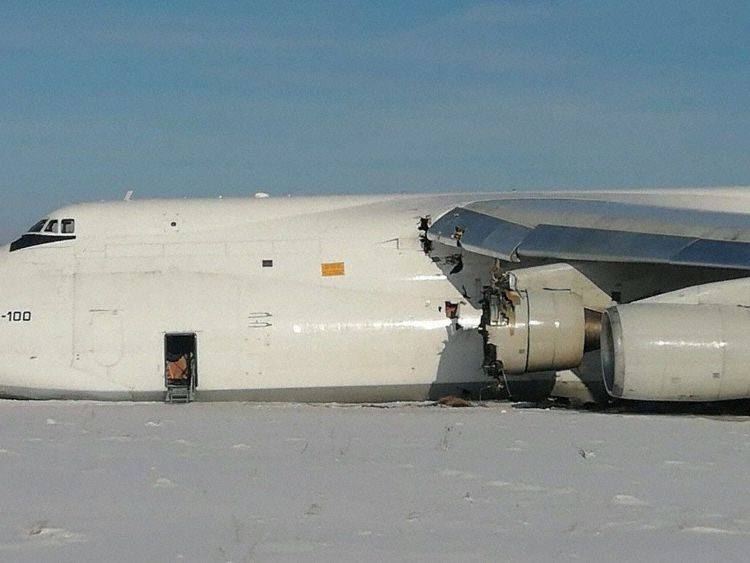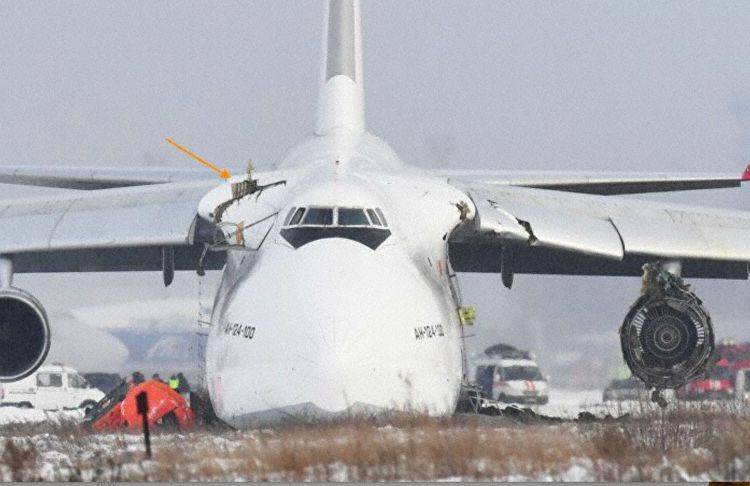A heavily-loaded Antonov An-124 returned for landing at Novosibirsk airport in Russia. It appears to have suffered an uncontained engine failure. Volga-Dnepr operates the aircraft, registered RA-82042. Pictures show engine No2 to have lost its fan disk and with it the cowling that failed to contain it. Other pictures show fragments of the fan disk in a warehouse on the ground, and the cowling in a field.

The aircraft came to rest ~200 m behind the end of runway 25. There were 83.5 tons of cargo on board at the time. Meanwhile, the missing cowling belonging to engine #2 was found in a field. https://t.co/OyZYofdzrqhttps://t.co/FN0SFYX5pv pic.twitter.com/pnff8Sorpg
— JACDEC (@JacdecNew) November 13, 2020
The accident reportedly happened shortly after take off. Videos show the plane returning for landing, and making what appears to be an uneventful approach and touchdown. However it then failed to stop before the end of the runway. So, observers report it coming to a rest 200 metres beyond the run off area of runway 25.
The incident resulted in a total loss of communications and also the loss of transponder signals. High energy fragments caused substantial damage to the wing root, inner slats and fuselage. Ground damage about 2 NM west of the airport.https://t.co/CmR1efQSKw pic.twitter.com/Rgqe0SRRoH
— JACDEC (@JacdecNew) November 13, 2020
The runway excursion caused the nose gear to collapse, but all 14 people on board were able to exit the aircraft without injuries. More pictures show the extensive damage on the aircraft’s leading edge surfaces near the failing engine. The damage extends to the fuselage itself, on both sides of the Antonov, in line with the uncontained engine’s disk.

Other Effects Of The Antonov’s Uncontained Failure
It is unclear if this damage was a direct result of the engine failure or the runway excursion. Avherald opines that disk fragments penetrated the fuselage on multiple locations, with some exiting from the right side.

More reports say that the aircraft was unable to communicate with ATC after the engine failure. And the tower also lost the transponder signal from the aircraft, as it climbed through 1800 feet MSL. This strongly suggests that the damage affected systems beyond the engine itself.
It is not known if the runway excursion was the result of a fast landing, or something to do with system failures (like hydraulics) in the aircraft. Twitter user @JacdecNew reports that the aircraft had 83.5 tons of cargo on board. Considering the weight, the damage on its leading edge surfaces and with possible damage in other systems, it’s not surprising that the crew had an abnormal landing.
We will know more soon. West Siberia’s Transport Prosecution Office have reportedly began an investigation on the incident.
Update:
AvHerald have updated their information, with an interview of the pilot:
In a videotaped interview the captain of the flight reported that the #2 engine (inboard left) blew up at about 1000 feet AGL (300 meters above ground) just after gear retraction with flaps still extended for takeoff, debris damaged the aircraft’s cabling and took out all electrical supply resulting in the loss of all eletrical systems including instruments, brakes, thrust reversers etc. The aircraft remained controllable despite all electricity gone and all communication, even intercom having failed, lost. The crew attempted to establish visual contact with tower, however, without success, and proceeded to land on runway 25 with very little margin due to low altitude and engine thrust. After a smooth touchdown the overrun was unavoidable due to the loss of brakes, spoilers, thrust reversers.
Update 2:
A further video emerged, showing the aircraft going beyond the end of the runway, before coming to a stop.




5 comments
Spyros
Hi,
If you check the video link under Update 2, you’ll see the plane leaning forward at the moment the nose gear collapses at the end of the runway. Until that point the plane was horizontal.
Ramiro
Hi There,
is it possible that the pilot has retracted the main landing gear to stop the plane? not only the gear is not visible in the picture (it could be due to the snow) but also the airplane looks pretty “horizontal”, not leaning forward due to the broken nose gear.
Thanks!
sean beukes
Looking at that fan disk it looks like it had a fatigue crack on the inner side, which finally grew large enough that the rest of the disk failed at peak stress. You can see the darker older damage and then the rest of the surface has a fresh failure. This likely is the piece that went entirely through the cabin.
https://avherald.com/img/volga-dnepr_a124_ra-82042_novosibirsk_201113_4.jpg
Spyros
Thank you!
Oleksiy Sokolov
This is what the pilot said shortly after the accident:
(https://t.me/bazabazon/5163)
The second engine exploded and cut electric wires, so we lost all the electricity. And we returned to the aerodrome of departure on an airplane having a total electric failure. We lost all the communication, both intra-cockpit and with the ATC. We just gained 300m altitude at that point. We were a crew of 6, and other technical crew of 8, they were in the rear cabin. We took a decision to return to the aerodrome of departure, visually, we tried to establish visual communication but that didn’t work. We took a decision to land on RWY25, since it was a critical situation and we took a decision to land as soon as possible. Since we didn’t have a lot of altitude and excess of thrust too. There was a complete electric failure, brakes didn’t work, reverse didn’t work either since the wires were cut. The landing was soft, there was no damage during the touchdown, all the damage was due to the runway excursion. The gauges in the cockpit didn’t work, from the angle of attack we figured out the speed was about 280, it was a calculated airspeed. We haven’t even raised the flaps at that time, just raised the gears and we heard a bang. We still had control, but the electrical system failed completely.